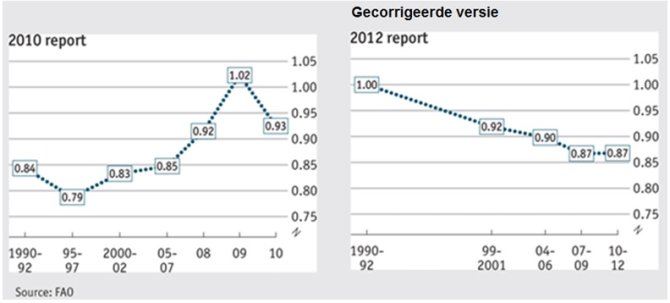Blog post
BLOG - How will we feed 9 billion people in 2050?
October 16 was World Food Day. This year’s theme was "Sustainable food systems for food security and nutrition ". A fairly abstract theme. But actually, the theme is basically about the question "how do we feed 9 billion people in 2050 (in a sustainable way)?"

I think the timing of this focus on "Food Systems" is not accidental. This year marks the fifth anniversary of skyrocketing food prices, which seemed to have come out of nowhere. Prices soon fell after that first peak, but rose again in 2010 to new record highs. This, apparently, has led to an awareness that the food system is under pressure: the demand is growing, while supply remains stable. If we cannot feed a billion people adequately now, how should we do this in 2050, when there will be 2 billion additional people to feed?
Ironically, it appears that there was no food crisis after all. The figures for "more than one billion hungry by high food prices" turned out to be not quite correct. The Food and Agriculture Organization of the United Nations (FAO) has changed these figures in 2012 (without much fanfare). The new figures (on the right-hand side) present a very different picture. Not only did the high food prices have no peak effect on the number of hungry people, but the picture that emerges from the new figures is that the number of hungry people has actually fallen.
An important reason for the differences between 2010 and 2012 is that the FAO has not included income growth. In the years that food prices increased, the income of many poor people in Africa and Asia also increased. The higher prices were more than amply offset by higher income. When economic growth began to decline after the financial crisis, but prices started to rise again (in 2010), the number of hungry people no longer decreased but remained the same.
This does not mean that there is no problem: 870 million hungry people are, of course, still far too many. The problem is that on the basis of wrong numbers about a "food price crisis", policymakers have been wrong-footed. If we are serious about thinking how we are going to feed 9 billion people by 2050, then we need reliable data and models that can support policy choices.
Do we have those? Partly. Specific data and models on food security are still relatively scarce. A few examples. LEI research in the field of food waste has encountered a lack of data on food waste in the supply chain (from production to consumption). Calculating which impact a reduction in food waste will have then becomes a difficult task. Another example. The question "can we feed the world?" is usually translated into "how many calories are available?" but not into “what is the nutritional value (fats, proteins etc)”, while this is crucial for healthy diets. Again, LEI is trying to get better data into models.
Finally, the issue about future scenarios. We recently made an inventory of model scenarios, which sketch different futures under certain assumptions. We found that hardly any scenarios exist that focus on food security. If food security is included, it is often indirectly. The models usually limit themselves to kilocalories; other dimensions, such as food prices, nutrition etc. are rarely taken into account, probably because of my previous point: lack of data.
If we want to think about different options on how we can feed 9 billion people by 2050 (sustainably!), we must invest in data, models and applications, to make more informed decisions.